Printing Out New Features

New card and badge printing systems now boast
rewritable card printer technology. Photo courtesy
Datacard
Nothing new in ID card printers? Think again.
There are printers that now can rewrite cards and badges or do both-side lamination at once; some printers are built to handle specialty IDing by type of business and even printers cranking out inexpensive radio frequency identification labels for product ID.
At the ASIS International exhibition in San Diego last month, printer makers showed off a diversity of products, of course. One that caught more than a few eyes is a card printer (Datacard SP25) that combines high-quality, dye sublimation and rewritable card printing technology in a cost-effective design for single-card printing applications. It produces color photo IDs, rewritable cards or cards that use both technologies. Such rewritable printing allows enterprises to rewrite cards and badges at least 500 times with dynamic information, such as loyalty points, class schedules or as a temporary visitor ID.
Numerous ID card printer makers concentrated new introductions at ASIS on such end-user needs as fewer moving parts, a significantly higher duty cycle as well as the ability – through one printer – to issue contactless and contact smart cards, proximity cards and IDs with magnetic stripes and barcodes.

Software and hardware combination can better serve
special news of applications such as airport IDing.
Photo courtesy Honeywell
SPECIALTY NEEDS
Card and printer makers also are targeting specialty industries. For example, Northstar Resort-at-Tahoe, Lake Tahoe, Calif., has installed an electronic locking system for visitors' lockers powered by LEGIC technology. Ski room lockers are fitted with high technology, battery-operated locks that include an integrated system for ski boot heating. The lockers are operated with LEGIC data carriers integrated in a user pass or multiple-user passes for the family lockers.For the transportation industry, Honeywell used ASIS to launch Pro-Watch Airport Pack, a system that features an upgraded badging application and additional interface capabilities specifically suited for airports and seaports. The pack aims at Secure Identification Display Area (SIDA) testing and management, and violation revenue management.
ID badging is as hot when it comes to product tracking.
For instance, a labeling solution that helps companies meet major retailer and Department of Defense (DoD) RFID and barcode identification requirements consists of scalable ItemSight software (Avery Dennison) bundled with a scanner, plus optional label production systems. The label production options include Avery Dennison’s AP5.4 and 64xx series printers, and ALX print/apply systems.
The software and scanner, along with optional printers, enable users to convert existing barcode container labels into labels that meet retailers’ and DoD barcode and/or RFID product identification requirements. In operation, a user simply scans the barcode that currently exists on a container. The software then converts the barcode’s data to EPC- and DoD-compliant 96-bit formats, such as SGTIN, SSCC96 and DoD96. The converted files can then be electronically transmitted to customers and vendors. With an optional printer, users can produce Gen 2 RFID-enabled labels and bar coded labels for application beneath the existing container label.
SIDEBAR
Smart Cards For China
The Industrial Commercial Bank of China (ICBC) just decided on a fully integrated smart card solution driven by Datacard Affina data preparation software. “The issue of security should not be treated as a simple thing. While all other countries are raising their security levels, those who lag behind will easily be a target for attack,” said Zhihong Xu, general manager of the bankcard department for ICBC. “Thus, China will be at high risk of becoming the new target for card fraudulence if (a more secure) program is not implemented soon.”The smart card issuance and management software suite enables card issuers to introduce smart cards into their existing production environments. “The significant memory capacity of the cards forms a new business development platform for banks,” said Xu. “It is essential to cardholders because large varieties of information can be securely stored and updated instantly on smart cards, including membership information, credit rewards, transaction records as well as other personal cardholder information.”
Looking for a reprint of this article?
From high-res PDFs to custom plaques, order your copy today!







